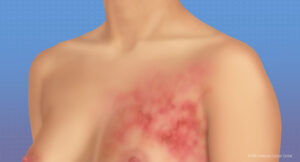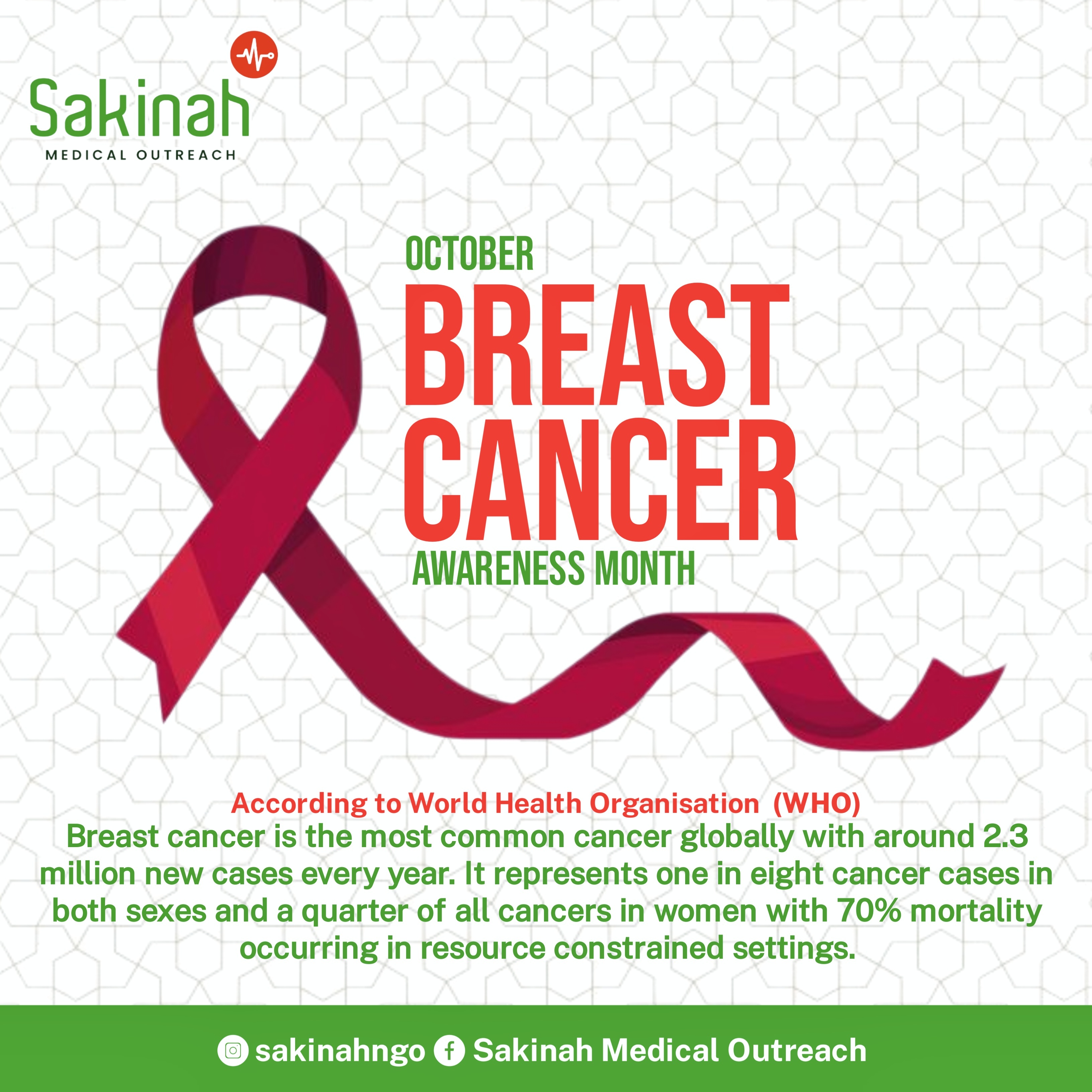Breast cancer is a type of cancer that develops when cells in the breast grow uncontrollably and form a tumor. Breast cancer is the most common cancer globally, with around 2.3 million new cases every year. It represents one in eight cancer cases in both sexes and a quarter of all cancers in women, with 70% mortality occurring in resource constrained settings. In 2022, breast cancer remained a leading health concern, resulting in an estimated 670,000 fatalities globally, emphasizing the need for continued awareness, research, and early detection efforts.

Depiction of inflammatory breast cancer with rash symptom Source: MD Anderson Cancer Center.
Sharing awareness about breast cancer is an everyday task to save more lives, but the month of October is deeply dedicated to sharing more awareness vigorously on breast cancer so that people can be aware of their risk factors, as it will be highlighted in this write-up. In fact, it’s time to shed light on this disease that affects millions of people worldwide. With early detection and advancement in treatment, survival rates are improving.
Signs & Symptoms
The signs and symptoms of breast cancer may include a lump in the breast, a change in breast shape, dimpling of the skin, milk rejection, fluid coming from the nipple, a newly inverted nipple, or a red or scaly patch of skin.
Risk Factors of Breast Cancer
Anything that increases the risk of getting a disease is called a risk factor. Having a risk factor does not mean that one will get cancer; not having risk factors doesn’t mean that one will not get it. Talk with your doctor if you think you may be at risk. The following are the identifiable risk factors for breast cancer:
- Being female
- Age (mostly over 40 years of age)
- Obesity
- Genetics and Family history of breast cancer
- Lack of exercise,
- Alcohol consumption
- Hormone replacement therapy during menopause,
- Previous radiation therapy
- Early age at first menstruation,
- Having children late in life or not at all, older age,
- Previous history of breast cancer,
- Klinefelter syndrome
Diagnostic Method of Breast Cancer
Breast Cancer can be diagnosed with any of the following approaches but the most recognized one nowadays is the use of Mammogram.
- Tissue biopsy
- Mammography
- Ultrasonography
Prevention
Although breast cancer cannot be prevented, the risks of developing breast cancer can be minimized through specific preventive activities. These include achieving changes in lifestyle, diet, breastfeeding, overall physical characteristics, and obesity, and interventions for women at high risk of developing breast cancer using tamoxifen and other anti-estrogen compounds.
Screening, Management and Early Detection
Early detection
The most important and beneficial area of protection activities is the early detection of breast cancer, which can be detected through screening. Diagnosis of breast cancer during the early stages of disease has been positively linked to a decrease in the mortality and morbidity of the illness.
There are numerous approaches to breast cancer screening. These include:
- Breast self-examination
- Clinical breast examination
- Mammography
Breast cancer management is determined by the individual’s overall health, the molecular profile of the cancer, and the extent of tumor spread at the time of diagnosis.
Management strategies include:
- Surgery
- Radiation Therapy
- Chemotherapy
- Hormone Therapy
- Targeted Therapy
- Immunotherapy
- Stem Cell or Bone Marrow Transplant
- Precision or Personalized Medicine
- Palliative Care
- Combination Therapy
Breast Cancer in Men

Source: ResearchGate
Although breast cancer in men only makes up less than 1% of all cases of breast cancer, it is equally important to promote awareness and education among men too, to ensure timely diagnosis and treatment. A family history of breast cancer and other factors can increase a man’s risk of breast cancer.
Risk factors for breast cancer in men may include the following:
- Treatment with radiation therapy to your breast/chest.
- Having a disease linked to high levels of estrogen in the body, such as cirrhosis (liver disease) or Klinefelter syndrome (a genetic disorder).
- Having one or more female relatives who have had breast cancer.
- Having mutations (changes) in genes such as BRCA2.
Prognosis
The NCI reports that 90.8% of trusted sources of women with breast cancer survive for 5 years after diagnosis. This survival rate includes all women with breast cancer, regardless of the stage.
Global impact
Age-standardized breast cancer mortality in high-income countries dropped by 40% between the 1980s and 2020 (1). Countries that have succeeded in reducing breast cancer mortality have been able to achieve an annual breast cancer mortality reduction of 2–4% per year.
The strategies for improving breast cancer outcomes depend on fundamental health system strengthening to deliver the treatments that are already known to work. These are also important for the management of other cancers and other non-malignant noncommunicable diseases (NCDs). For example, having reliable referral pathways from primary care facilities to district hospitals to dedicated cancer centres.
The establishment of reliable referral pathways from primary care facilities to secondary hospitals to dedicated cancer centres is the same approach as is required for the management of cervical cancer, lung cancer, colorectal cancer and prostate cancer. To that end, breast cancer is a so-called index disease whereby pathways are created that can be followed for the management of other cancers.
References:
- World Health Organization. Breast Cancer, 13 March 2024 | Available at: https://www.who.int/news-room/fact-sheets/detail/breast-cancer (Accessed 10 October 2024)
- National Library of Medicine. Breast Cancer—Epidemiology, Risk Factors, Classification, Prognostic Markers, and Current Treatment Strategies—An Updated Review, 25 August 2021 | Available at: https://www.ncbi.nlm.nih.gov/pmc/articles/PMC8428369/ (Accessed 10 October 2024)
- World Health Organization. | Available at: https://applications.emro.who.int/dsaf/dsa696.pdf (Accessed 10 October 2024)
- Wikipedia: | Available at: https://en.wikipedia.org/wiki/Breast_cancer (Accessed 10 October 2024)
- Healthline. How to Do a Breast Self-Exam, 29 July 2024 | Available at: https://www.healthline.com/health/breast-lump-self-exam?utm_campaign=feed&utm_medium=referral&utm_source=later-linkinbio ( Accessed 10 October 2024)
We’re excited to share our Mid-Year Report, highlighting the impactful strides we’ve made so far in 2024. From successful initiatives to heartwarming success stories, this report provides a comprehensive overview of our progress and the lives we’ve touched. Click the link below to explore the full report and see how your support has made a difference.
Access the following link to read through: https://sakinahoutreach.org/wp-content/uploads/2024/09/Sakinah-Medical-Outreach-Mid-Year-Performance-Report-2024..pdf

